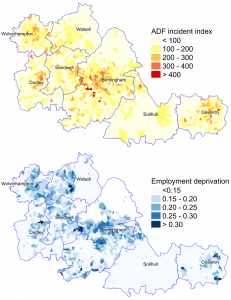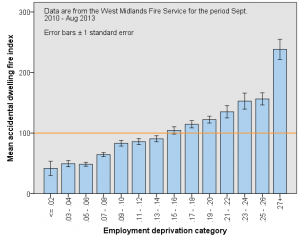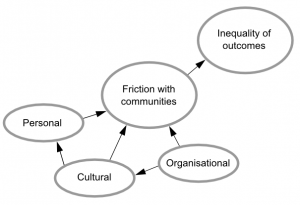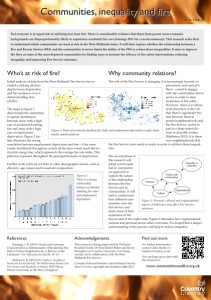This morning I presented my first ever academic poster. It was an internal faculty event for all the research students to showcase our work to our colleagues, so not too intimidating. Nevertheless, I was rather chuffed to win third prize for my poster. And since the poster is a good introduction to my research it seems sensible to do a web version for the blog. Here it is…
Introduction
Not everyone is at equal risk of suffering loss from fire. There is considerable evidence that those from poorer socio-economic backgrounds are disproportionately likely to experience accidental fire (see Jennings 20131 for a recent summary). This research seeks first to understand which communities are most at risk in the West Midlands today. It will then explore whether the relationship between a Fire and Rescue Service (FRS) and the communities it serves limits the ability of the FRS to reduce those inequalities. It aims to improve the lives of some of the most deprived communities by finding ways to increase the efficacy of fire safety interventions, reducing inequality and improving Fire Service outcomes.
Who’s at risk of fire
Initial analysis of data from the West Midlands Fire Service has revealed a striking relationship between deprivation and the incidence of accidental dwelling fires (ADFs).
The maps in figure 1 demonstrate the similarities in spatial distribution between areas with a high rate of accidental dwelling fire and areas with a high rate of employment deprivation.

Figure 1. Rates of accidental dwelling fire (top) and employment deprivation (bottom) show similar spatial patterns
Figure 2 further illustrates the strong correlation between employment deprivation and fire—if fire were evenly distributed throughout society all the bars would reach the horizontal orange line, which represents the average fire rate index. This pattern is repeated throughout the principal domains of deprivation.

Figure 2: There is a strong relationship between accidental dwelling fire rates and employment deprivation
Further work will look for links to other demographic factors, such as ethnicity, age, tenure and household composition.
Why community relations?
The role of the Fire Service is changing. It is increasingly focused on prevention, and central to this is a need to engage with the communities that it serves in order to raise awareness of fire safety. However, there is evidence from elsewhere in the UK that there is significant friction between those in poorer neighbourhoods and the Fire Service, rooted in part in a deep-seated distrust of all public bodies2. It is those very neighbourhoods that the Fire Service most needs to reach in order to address these inequalities.
The second phase of this research will adopt a more qualitative, interpretative approach to explore the nature of the relationship between the Fire Service and its communities. It will seek to understand how different communities view the Fire Service and make sense of their experience of the Service and of the wider state. Figure 3 illustrates how organisational, cultural and personal factors affect outcomes. It is hoped that a deeper understanding of this process will help to reduce inequality.

Figure 3. Personal, cultural and organisational aspects of behaviour may affect Fire Service outcomes
- Jennings, CR (2013). Social and economic characteristics as determinants of residential fire risk in urban neighborhoods: a review of the literature. Fire Safety Journal, 62 (A): 13–19. DOI 10.1016/j.firesaf.2013.07.002 [↩]
- Matheson, K (2012). Fire fighters, neighbourhoods and social identity: The relationship between the fire service and residents in Bristol [Online]. PhD Thesis, University of the West of England. Available from: http://eprints.uwe.ac.uk/16692/ [Retrieved 14 November 2013] [↩]

